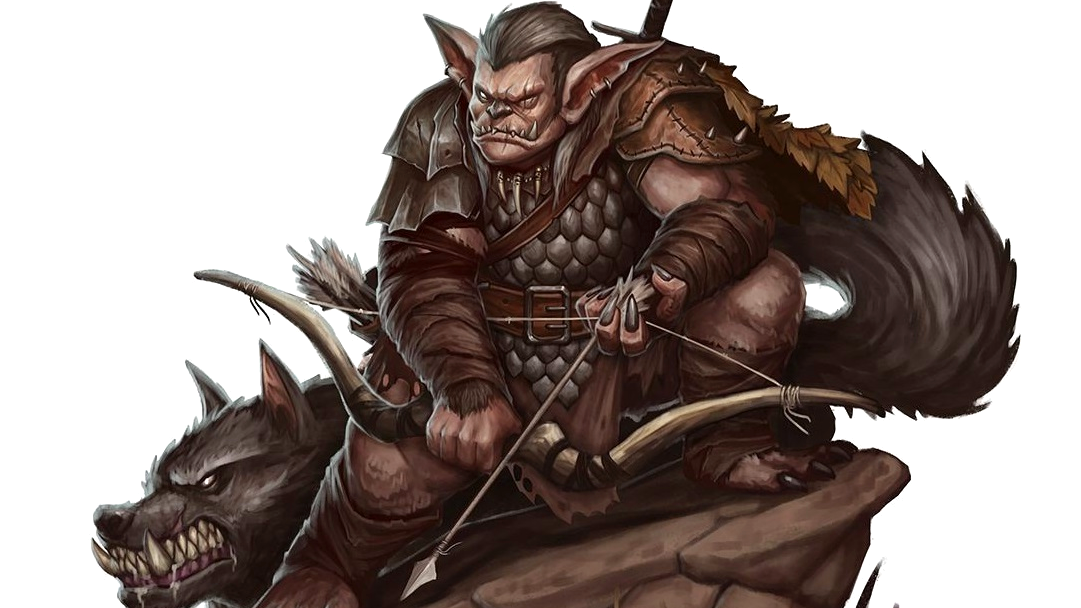
Bugbears feature in the nightmare tales of many races — great, hairy beasts that creep through the shadows as quiet as cats. If you walk alone in the woods, a bugbear will reach out of the bushes and strangle you. If you stray too far from the house at night, bugbears will scoop you up to devour you in their den. If a bugbear cuts off your head, your soul stays trapped inside, and the bugbears use your head to magically command all whom you once knew.
Lurid tales such as these have flowered from the seeds of truth. Bugbears do rely on stealth and strength to attack, preferring to operate at night. They do take the heads of enemy leaders, but they are no more likely to eat people indiscriminately than humans are. Bugbears aren’t likely to attack lone travelers or wandering children unless they clearly have something to gain by doing so. From the viewpoint of the rest of the world, their aggression and savagery are thankfully offset by their rarity and lethargy.
Bugbears typically give birth to one child at a time, twins are rare but are considered blessings from the brothers Hruggek and Grankhul
Bugbears reach adulthood at age 16 and live up to 80 years.
Since bugbears aren’t a particularly fecund race, their overall population is small and spread over a wide area. Bugbears live in family groups that operate much like gangs. The individuals in a group typically number fewer than a dozen, consisting of siblings and their mates as well as a handful of offspring and an elder or two.
In good times, a bugbear gang is tight-knit, and its members cooperate well when hunting or bullying other creatures. But when the fortunes of a gang turn sour, the individuals become selfish, and might sabotage one another to remove opposition or exile weaker or unpopular members to keep the rest of the gang strong. Fortunately for the race as a whole, even young and elderly bugbears have the ability to survive alone in the wild, and the cast-off members of a gang might eventually catch on with a different group.
Left to their own devices, bugbears have little more impact on the world than wolf packs. They subsist by crafting simple tools and hunting and gathering food, and gangs sometimes come together peacefully to exchange members and goods between them.
Bugbears prominent facial features are their large, hairy, wedge-shaped ears and eerily bright eyes, typically yellow, orange, red, brown or greenish-white in color.
A gang lives in and around a small enclosure, often a natural cave or an old bear den, and it might have supplementary dens elsewhere in its territory that it uses temporarily when it goes on long forays for food.
Bugbears, like most goblinoids, are considered to be dimwitted and brutish.
Bugbear are capable hunters at night and utilize their natural darkvision to ambush travellers
Bugbear names are similar to orc and goblinoid names; they are harsh and simple, much like the bugbears themselves.
Male Names: Bao'or'et, Cretin, Gregek, Kugruet, Malka'vec, Thimdul.
Female Names: An'hek, Gretru, Lungra, Sept, Um'ra, Zel.
Lifespan
80 years
Average Height
Males: 7'
Females: 6'8"
Average Weight
Males: 300lbs
Females: 250lbs
Average Physique
Bugbears resemble hairy, feral goblins with tall powerful bodies. Bugbears earned their namesake from their noses and claws, which were similar to those of bears.
Body Tint, Colouring and Marking
Bugbears are covered from head to toe in thick fur that keeps them warm and protects them from the harsh elements. Bugbear fur typically ranges from yellowish to reddish-brown in color.
Bugbear
Ability Score Increase +1 Dex, +2 Str
Size Medium
Speed 30 ft
Darkvision You can see in dim light within 60 feet of you as if it were bright light, and in darkness as if it were dim light. You can’t discern color in darkness, only shades of gray. Long-Limbed When you make a melee attack on your turn, your reach for it is 5 feet greater than normal. Powerful Build You count as one size larger when determining your carrying capacity and the weight you can push, drag, or lift. Sneaky You are proficient in the Stealth skill. Surprise Attack If you surprise a creature and hit it with an attack on your first turn in combat, the attack deals an extra 2d6 damage to it. You can use this trait only once per combat.
Languages. You can speak, read, and write Common and Goblin.


Comments